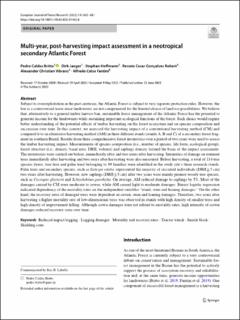| dc.description.abstract | Subject to overexploitation in the past centuries, the Atlantic Forest is subject to very rigorous protection rules. However, the law is a controversial issue since landowners are not compensated for the limited choice of land use possibilities. We believe that, alternatively to a general timber harvest ban, sustainable forest management of the Atlantic Forest has the potential to generate income for the landowners while sustaining important ecological functions of the forest. Such choice would require better understanding of the potential effects of timber harvesting on the forest ecosystem and on species composition and succession over time. In this context, we assessed the harvesting impact of a conventional harvesting method (CM) and compared it to an alternative harvesting method (AM) in three different stands (stands A, B and C) of a secondary forest fragment in southern Brazil. Results from three comprehensive forest inventories over a period of two years were used to assess the timber harvesting impact. Measurements of species composition (i.e., number of species, life form, ecological group), forest structure (i.e., density, basal area, DBH, volume) and saplings density formed the basis of the impact assessment. The inventories were carried out before, immediately after and two years after harvesting. Intensities of damage on remnant trees immediately after harvesting and two years after harvesting were also measured. Before harvesting, a total of 114 tree species (trees, tree fern and palm tree) belonging to 49 families were identified in the study site’s three research stands. Palm trees and secondary species, such as Euterpe edulis, represented the majority of recruited individuals (DBH ≥ 5 cm) two years after harvesting. However, new saplings (DBH ≤ 5 cm) after two years were mainly pioneer woody tree species, such as Cecropia glaziovii and Schizolobium parahyba. On average, AM reduced damage to saplings by 5%. Most of the damages caused by CM were moderate to severe, while AM caused light to moderate damages. Binary logistic regression indicated dependency of the mortality rates on the independent variables “stand, stem and leaning damages.” On the other hand, the recovery rates of damaged trees were dependent on crown, stem and leaning damages. Therefore, two years after harvesting a higher mortality rate of low-dimensional trees was observed in stands with high density of smaller trees and high density of improvement felling. Although crown damages were not related to mortality rates, high intensity of crown damages reduced recovery rates over time. | en_US |

